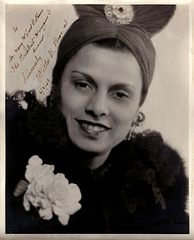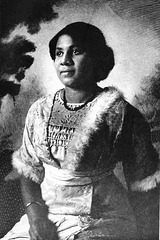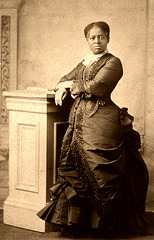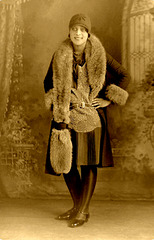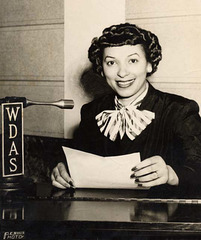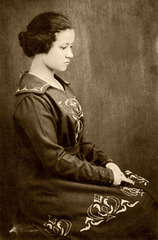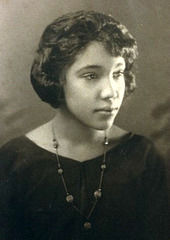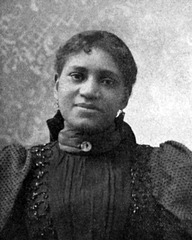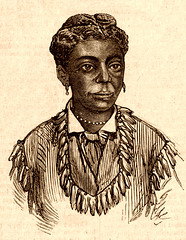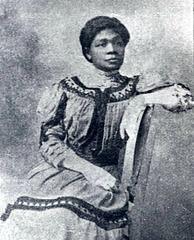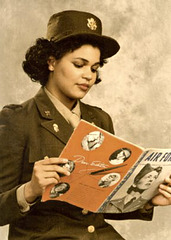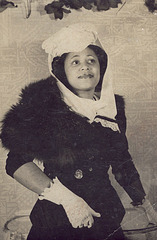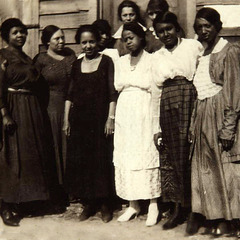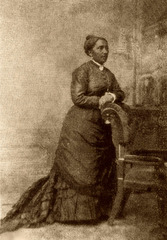
She Rose
HE·ROES,
1) A person, typically a man, who is admired for courage or noble qualities.
2) A person who, in the opinion of others, has heroic qualities or has performed a heroic act and is regarded as a model or ideal.
Mrs. Rosa Lula Barnes
| |
|
The National Cyclopedia of the Colored Race (Vol. 1), 1919. In recent years the Negro woman has begun to find herself. Time was when both by herself and in the minds of the general public it was decided, yea determined, that her place was in the home, in the school room and in the Sunday School. Gradually she got into founding institutions, schools, social settlements and the like. She went on the lecture platform. She traveled in America and in Europe as a singer. In all these places she found herself a complete success.
Then a few ventured into unheard of fields ... into politics and in business. Again success is crowning their endeavors. Why should they not enter any and all branches of work?
One of the leading Negro women in business, and general social work is Mrs. Lula Barnes of Savannah, Georgia. Though an Alabamian by birth and education Mrs. Barnes is a Georgian by adoption and achievement. She was born in Huntsville, Alabama, August 22, 1868, she had many difficulties in getting an early education. However, Huntsville Normal and Industrial Institute was near at hand; and so after several years she entered here and gained her life training.
Soon after her school days she was married and set about to make a happy home and to aid her husband in every possible way. Providence deemed it otherwise. Spurred by adversity, she now began to cast about a livelihood. Living in Savannah, she thought she saw an opening for a Negro grocery. She thought also that a Negro woman should just as well conduct this business as could a man. Hence she launched forth into the business. She opened a store on Price Street, and by courtesy, fair dealing and shrewd business tact made her store one to be reckoned with in the business world. For ten years she was a grocer, and gave up, or sold out, only to enter other fields. She closed her grocery books in 1893.
During her ten years in business Mrs. Barnes had practiced economy. She now made several paying investments. She bought a handsome residence, which is her home, on East Henry Street. She bought twelve rent houses, which in themselves provide her with a pretty comfortable income. She also owns five vacant lots in Savannah.
Having made these investments, which were safe and which would protect her in case of inability, she felt safe in placing money in several worthy enterprises. She owns stock and is a director in the Wage Earner's Bank of Savannah, in the Standard Life Insurance Company, in the Afro-American Company and in the Union Development Company.
Mrs. Barnes was married to Mr. Richard Barnes of Savannah on August 16, 1884. He died in 1911.
Lucretia H. Newman Coleman
| |
|
|
In her 1890 book, "Poor Ben: A Story of Real Life," based on the life of Benjamin William Arnett, the seventeenth bishop of the AME Church. In the dedication section she wrote: "I dedicate this work with sincere love for my race. To the colored young men and women of America, with the hope that it may contribute something to that Christian knowledge, which is the very breath of all true nobility." ~ The Author
Lucretia H. Newman Coleman lived in Appleton, Wisconsin for only a short time, from around 1867 to about 1876. Her family moved to Appleton, from Cincinnati after the death of the family’s patriarch, Baptist Minister and Abolitionist, Reverend William P. Newman in 1866.
She entered Lawrence University as a freshman in September, 1872, enrolling in a scientific course and staying for about two years. She was one of the earliest African American students to enroll at Lawrence. Some biographies state she graduated from Lawrence, but the University Archives has no record of her being awarded a degree. Lucretia was born in Dresden, Ontario, Canada around 1854. Her family moved from Canada to the West Indies, then back to Cincinnati and finally to Appleton. She married Robert J. Coleman in Des Moines, Iowa in 1884 and soon moved to Minneapolis where her daughter Roberta was born. Eventually she and Roberta moved to Chicago where her entry in 1920 census listed her occupation as dressmaker.
She had a distinguished career as an author in the 1880s and into the 1890s, writing articles published primarily in African American journals such as Our Women and Children and the A.M.E. Review, in addition to a biographical novel and poetry. In The Afro-American Press and Its Editors (1891), Irvine Penn states that her writings were “rich in minute comparisons, philosophic terms, and scientific principles.” Martin Dann writes in The Black Press 1827-1890: The Quest for National Identity (1971) that her poem “Lucille of Montana” (1883) was praised at the time as being “full of ardor, eloquence and noble thought.” A contemporary account in the journal The American Baptist said “As a writer, her fame is spreading, not only in one or two states, but throughout the United States. Should she continue with the same success in the past, she will be equal to Harriet Ward Beecher Stowe, if not her superior.” And in Noted Negro Women, Their Triumphs and Activities (1893), Monroe Alphus Majors writes she contributed to black journals with her “usual fascination for saying things in her own way.”
Bio: Neighborhood News (The Newsletter of the Old Third Ward Neighborhood Association, Inc.,) Winter 2016 editors Antoinette Powell and Linda Muldoon.
Willa B Brown
| |
|
|
|
Photo signed by Ms. Brown, "To Dr. Mary McLeod Bethune "The Greatest Woman I Know" Sincerely, Willa B. Brown 6/9/1943 [Mary McLeod Bethune Foundation, Daytona Beach, Florida] [Willa Beatrice Brown Chappell. RICHES of Central Florida]
A portrait of Willa Beatrice Brown Chappell, which is housed at the Mary McLeod Bethune Foundation, located at 640 Dr. Mary McLeod Bethune Boulevard in Daytona Beach, Florida. Chappell was the first African-American woman in the United States to earn a commercial pilots license and the first black female officer in the Civil Air Patrol. Brown was born on January 22, 1906, in Glasgow, Kentucky. She graduated from the Indiana State Teachers College in 1927 and received a Master's of Business Administration from Northwestern University in Chicago, Illinois, in 1937. After pursuing careers in education and social work, she later decided to take flying lessons from Cornelius R. Coffey, who she would later marry. The couple co-founded the Coffey School of Aeronautics at Harlem Airport in Chicago.
Brown, Coffey, and Enoch P. Waters also established the National Airmen's Association of America in 1939. The NAAA's main objective was to persuade the United States military to allow black aviation cadets. As an equal rights activist, Coffey lobbied the government for the integration of the Army Air Corps and the Civilian Pilot Training Program. Congress later voted to allow "separate but equal" participation in civilian flight training programs, designating the Coffey School as the facilitator of the African-American program. Brown became the coordinator for the CPTP in Chicago and the Coffey School later provided training for the Tuskegee Airmen. Brown also served the Civil Aeronautics Authority as a coordinator and the Federal Aviation Administration's Women's Advisory Board as a member. She died on July 18, 1992.
Ora Brown Stokes
| |
|
|
Ora Brown Stokes (1882 - 1957), was born in Chesterfield County and raised in Fredericksburg, Virginia. During her life, she worked to improve the lives of African American women and girls. For twenty years she was employed as a probation officer with the Richmond City Juvenile Court. She organized the National Protective League for Negro Girls and a local chapter of the Council of Colored Women. In 1912, she started the Richmond Neighborhood Association to help black working women, and it quickly expanded to support a nursery, a residence for young girls, and other community services. Stokes was also president of the Southeastern Section of the National Association of Colored Women's Clubs and the Virginia Negro League of Women Voters.
Info and Image: History of the American Negro (Virginia Edition), 1921.
Lucretia ‘Aunt Lou’ Marchbanks
| |
|
Lucretia Marchbanks was one of the most interesting and most beloved people in Deadwood, South Dakota’s pioneer days.
She was born into slavery on March 25, 1832, in Putman County, Tennessee, the oldest of eleven children. She was the bondswoman of Martin Marchbanks, whose father had settled near Turkey Creek east of Algood, Tennessee. Her father, of mixed racial heritage, was a half-brother of Martin Marchbanks.
Prior to the enactment of the 13th Amendment, before the firing of the guns at Fort Sumter had announced the opening of the U. S. Civil War, her liberty-loving father had purchased his freedom with $700 which he had saved over the years.
Lucretia Marchbanks, who acquired her father’s frugal industrious habits, grew to womanhood on the master’s estate where she was fully trained in housekeeping and the culinary arts.
Her master, Martin Marchbanks, gave Lucretia to his youngest daughter whom she accompanied to the Western frontier, reputed a land of gold, fortune and romance. They traveled and lived for a period time in California, and later, a free woman, she returned to her old home in Tennessee. Once again, Lucretia set out again for the untamed west where she remained for the rest of her life. Like many others, she was lured into the Black Hills by reports of gold. Lucretia joined the “Black Hills Gold Rush,” arriving in historic Deadwood Gulch, a bustling mining camp, on June 1 1876, where she secured a job, working as the kitchen manager in the Grand Central Hotel. Soon, the hotel, which really wasn’t that grand, was better known for the great food served by Lucretia in the frontier hotel’s restaurant.
“Aunt Lou,” as she was known, labored hard to make her way in a sometimes unforgiving boomtown of the West. Except for “Aunt Sally” Campbell, who came with the George Armstrong Custer Black Hills Expedition in 1874, most believe that Lucretia Marchbanks was the first black woman to live in the Black Hills of the Dakota Territory.
After she left the kitchen, Lucretia worked for four successive mine superintendents for the small sum of $40 per month. That was a small price, a real bargain for anyone who could afford to employ a woman with her ability and training.
Two years later she was offered a better position as a cook for the Golden Gate Mine in nearby Lead. Her work ethic, loyalty to duty and fine character were evident to all who knew her. She then left Deadwood to become the manager of the Rustic Hotel at the DeSmet Mine. Gossip of her culinary skills spread like a wildfire and she was soon hired away again as a cook and housekeeper for a boarding house owned by Harry Gregg in Sawpit Gulch, also in Lead. They catered to the DeSmet Mine workers.
One historical account tells that when she was late getting back from a meeting, she was still able to fix an evening meal for the miners in 25 minutes, plus lunch buckets for all on the night shift. Contrary to what was seen on the HBO series “Deadwood,” Lucretia Marchbanks was never an employee of George Hearst, the owner of the world famous Homestake Mine. Her final employer was Harry Gregg, with whom she worked until 1883 when she resigned and opened her own establishment, the Rustic Hotel at the mouth of Sawpit Gulch located just down the road from Deadwood.
She was considered to be the finest cook in the Black Hills at that time. She has been regaled for her excellent plum puddings, among other culinary delights. A Mr. William A. Reamer, who boarded with her, asked her for the recipe and she replied, “Oh, just a handful of this and a handful of that.” Lucretia was more commonly known throughout Deadwood and the Black Hills as “Aunt Lou.” She was also lovingly known to some people of the area as “Mahogany Lou” Marchbanks.
For example: The New York Stock Exchange in discussing a Black Hills Mining News article asked “Who is Aunt Lou?” The Black Hills Daily Times answered in an article entitled “We’ll Tell You Who She Is” - Aunt Lou is an old and respected colored lady who has had charge of the superintendent’s establishment of the DeSmet mine as housekeeper, cook and the 'superintendent of all superintendents’ who have ever been employed at the mine. Her accomplishments as culinary artist are beyond all praise. She rules the house where she presides with autocratic power by Divine right brooking no cavil or presumptuous interference. The mine superintendent may be a big man in the mines or the mill but the moment he sets foot within her realm he is but a meek and ordinary mortal.
“She is a skillful nurse as well as a fine cook and housekeeper, her services to the victims of mountain fever never received an even part of the praise to which they are entitled.” There was a festival in the City Hall of Golden Gate in 1880 for the purpose of the raising of funds for the Congregational church, a prize of a diamond ring was raffled off and then given to the most popular woman in the Black Hills. Her competitors for this high honor were a sizable number of popular white women. Many men and women, citizens of all walks of life voted with their money for their favorite woman: “Aunt Lou.” She easily won and was awarded the coveted prize.
She was however, was more than just a kind friendly woman with great cooking skills; she was also a tough and demanding kitchen manager and stood no intimidation from her rowdy patrons. It is said that on one day she proved that when a Mexican man came into the restaurant boasting that he had killed an Indian and acting as though he’d like to do the same again … kill someone else. While nervous customers looked on, “Aunt Lou” confronted him while brandishing a large knife and in no time, the stranger was quick to take his leave.
Lucretia finally decided that she had cooked long enough. She retired from the Rustic Hotel business in 1885 and sold the hotel to a Mrs. A.M. Porter. “Aunt Lou” purchased a ranch at Rocky Ford, Wyoming, (between Sundance and Beulah) from A. C. Settle. She moved to the ranch that same year and was very active in raising cattle and horses. She with the help of a hired hand named George Baggely, who worked for Lucretia for 20 years and managed the ranch. Various historical records show that she conducted her ranch in the very businesslike manner everyone would have expected.
She died in 1911 and is buried in Beulah Cemetery.
Black Hills Pioneer, Destination Deadwood, by David K Whitlock
Annie Mae Manigault
| |
|
Annie Mae Manigault Hurley (1907 - 1976), graduated from the Renouard School of Embalming in New York City, and then began her fifty-year career by working with her parents (Annie Rivers and William Manigault) in the Manigault Funeral Home in Columbia, South Carolina.
In 1917, William and Annie Manigault (Annie Mae's parents) helped found the Manigault-Gaten-Williams Funeral Home, in Columbia, South Carolina. In 1923, the funeral home was renamed Manigault's Funeral Home. Both William and Annie were funeral directors and worked hard to serve families in need during a time when it was not easy for African American people to be in business.
Annie and William also founded the Congaree Casket Company, which employed more blacks during that time than any other black-owned business in South Carolina.
In the early 1950’s, William and Annie's daughter, Anna Mae, took over the family business, which she ran along with her son, Anthony.
Today, the Manigault-Hurley Funeral Home is run by Anthony Manigault Hurley, Alice Wyche Hurley, Michelle Manigault Hurley Johnson, and Kelly Lynn Hurley.
Sources: Richard S. Roberts, Photographer; University of South Carolina
First African American Female Disc Jockey in Phill…
| |
|
Bernice Thompson, who trained her voice by reading the fine print on cereal boxes and can labels became Philadelphia's first African American female disc jockey and TV personality almost a half century ago.
"She used to sit at the kitchen table and read the labels and fantasize about being a broadcast star," said her daughter, Juanita Thompson. When the opportunity came, she was prepared for a one-hour Sunday show on WDAS radio station, playing spirituals. Eventually, she became host of a two-hour daily "Bernice Thompson Show" during which she gave beauty tips and household hints between the music. She also held the position of Director of Women's Programs.
In the early 1960s, she took her show to a TV station in Wilmington, Delaware, before leaving the industry to become a public information officer for the Philadelphia Antipoverty Action Commission.
Ms. Thompson died April of 1996, of breast cancer at Howard University Hospital in Washington, DC. She was 75.
Source: WDAS History
Melissa Fuell-Cuther
| |
|
Melissa Fuell-Cuther’s out-of-print biography, "Blind Boone: His Life and Achievements," relates the highlights of Boone’s harrowing journey and also testifies to the struggles of many African Americans during the Jim Crow era. With the initial publication of the Boone biography in 1915, Fuell-Cuther broke ground as the first African American author to write about the life of a black musician. As a member of Boone’s concert company, she provided firsthand knowledge of Boone’s early years, his career performing tours across the country, and perhaps most importantly, his professional and personal relationship with John Lange, whom many at the time considered the best entertainment manager, black or white, in the country.
What little is known today about Fuell must be teased out from obituaries, news articles, and the book "Blind Boone, His Early Life and His Achievements" itself. Born in Warrensburg, Missouri, on May 15, 1886, she received her degree from the Lincoln Institute (now Lincoln University) in Jefferson City, Missouri. "I always wanted to attend the then Lincoln Institute State college at Jefferson City," she recalled. "Through interested teachers I found a way to work my way through Lincoln. I scrubbed the wood covered halls on my knees, as no one used mops." She graduated with second highest honors from Lincoln --- losing out on the highest honor, she believed, only because she was competing with a male student.
After graduation, Fuell traveled to Colorado where she searched for a teaching job while supporting herself as a house cleaner. She returned to Missouri when she was hired to teach first grade in Joplin, where she remained from 1905 to 1912. A talented singer who had performed as a child, Fuell joined the Blind Boone Concert Company at the suggestion of Emma Smith, the company's lead singer. Like other singers before her, Fuell also worked as the company secretary. After becoming acquainted with he skills, John Lange, (Blind Boone's manager) commissioned her to write a biography of John Boone, which, given Boone's popularity and fame, Lange expected to become a bestseller. Fuell also detailed the hardship and discrimination the troupe faced in the days of Jim Crow with a clear voice and no self pity, believing firmly in Lange's dictum that merit, not sympathy, wins. Two editions of the biography were published during her lifetime: one in 1915 by Burton Publishing Company of Kansas City, Missouri, and a later 1918 edition, published in Robbins, Tennessee, by the Evangel Publishing Society.
In 1915, Fuell left the company to promote the book, but despite her efforts and Boone's fame, the book had limited sales. The following year, she married Charles William Cuther of Carthage, Missouri. Cuther was a hotel employee renowned for his personality and sense of humor. He worked for more than fifty years at the Connor Hotel in Joplin, a popular stop for entertainers and celebrities. The couple purchased several properties, including apartment houses, where they hosted black performers such as Marion Anderson and Duke Ellington, who were refused lodgings at the area's whites-only hotels.
Fuell-Cuther's accomplishments as a community leader and educator were impressive during a time when blacks were barred from many places of work and education. When she saw a need, she did not allow the existence of segregation to stop her. One of her colleagues recalled in later years that "when politicians saw her coming, they knew it was business." Recognizing the importance of George Washington Carver to American history, she helped to preserve his home and later worked to establish the George Washington Carver National Park site, the first such site to honor an African American. She was instrumental in opening and supporting the George Washington Carver Memorial Nursery School on the Carver property, the first organization of its kind for working African American families in Joplin. The Carver property, under Fuell-Cuther's leadership, also became the site of Ewert Park, the first park for African Americans in Joplin. She formed the first African American Girl Scout troop in Missouri in 1946 and worked to develop many other projects within the black community, including Lincoln High School, the Ewert Park Little League and Camp Mintahama. She was also responsible for many blacks gaining entrance into the Santa Claus Christmas parade, a traditionally all-white affair.
After the death of her husband, she briefly lived in Kansas City with their daughter, Charlene Cuther Anderson, but returned to live out her remaining years in Joplin.
After her death in 1968, the community erected a monument in her honor at the George Washington Carver Memorial Nursery School. The plaque is dedicated to "Melissa Cuther: Educator, Founder, Humanitarian." In an interview shortly before her death, Melissa Fuell-Cuther reflected, "There are so many beautiful opportunities to help make the world a better place in which to live."
Sources: Merit, Not Sympathy, Wins: The Life and Times of Blind Boone edited by Mary Collins Barile, Christine Montgomery (2012)
Florestine Perrault Collins
| |
|
Self-portrait of the photographer early 1920s.
Florestine Perrault Collins (1895 - 1988), one of only 101 African American women identified in the 1920 U.S. Census as a photographer. She transformed what began as a portraiture studio in her living room into an unrivaled legacy of authentic expression that defied the oppressive racial and gender barriers of her time. Born into a large Creole family, Collins began working as a photographer at age 14 to help alleviate her family’s debt problems, though Jim Crow-era racism forced her to hide her racial identity in the troubling New Orleans tradition of passing for white. A capable entrepreneur, Collins grew her business from portraits of family and friends to become a photographer renowned for capturing subjects from weddings to high-school graduations to visits from soldiers during World War II. While always true to her craft, Collins sought to enhance her subject’s natural beauty and sensuality in images that stand in stark contrast to the period’s prevailing stereotypes.
Sources: New Orleans Historical Society; Encyclopedia of Louisiana, edited by David Johnson, Louisiana Endowment for the Humanities
A Woman of Many Firsts: Vernie Merze Tate
| |
|
She was the first African American graduate of Western Michigan Teachers College, first African American woman to attend the University of Oxford, first African American woman to earn a Ph.D. in government and international relations from Harvard University (then Radcliffe College), as well as one of the first two female members to join the Department of History at Howard University.
Vernie Merze Tate was born on February 6, 1905 in Blanchard, Michigan. The grandchild of the first Negro settlers in Mecosta County, Michigan, she lived a country life, however she longed to see the world outside the pine trees and dirt roads which surrounded her.
In 1927 she graduated from Western State Teacher’s College (later Western Michigan University) with the school’s highest academic record at that time.
Despite her stellar academic record, Colored teachers were not hired to teach secondary education. With the assistance of the college’s administration, she would go on to teach at Crispus Attucks High School in Indianapolis, Indiana. The school, founded by the city’s Klu Klux Klan, was an effort to segregate races. Tate, along with others, was hired by the school’s African American principal with the intent to teaching Colored students to excel beyond the founders’ intentions.
As African Americans fought through Jim Crow laws stifled the life of many, Tate decided to explore the world and use her talents and gifts on a broader scale. She would travel the world, twice; serve as an international reporter for the Afro American Newspaper in Baltimore, work as a photographer, filmmaker and researcher for the U.S. State Department, all while being a college professor.
Her educational background would include being professor and dean for Barber-Scotia College, Bennett College, Morgan State College, and Howard University where she worked from 1942-1977.
She died in 1996 at the age of 91, however her legacy lives on. She has left millions to institutes of higher learning who looked beyond her race and gender to provide her with a stellar education. Western Michigan University, Radcliffe College-Harvard University, and Howard University received everything from million-dollar contributions, to archival documents upon her death.
Tate never married, or had children. Her four siblings did marry, however, none had children. Members of her family include distant cousins who are proud of the legacy she left behind.
Source: Western Michigan Archives
Mary Davenport
| |
|
In 1900, Mary Davenport was president of the Chicago Woman's Conference which dealt with the suffrage movement. Because of the southern strategy adopted by much of the white women suffrage movement, African American women formed their own organizations to fight for the right to vote. NYPL
Miss Ruth M. Lowery
| |
|
An 1878 sketch titled, “Ruth Lowery, Foundress of Silk-Culture in Alabama" appeared in Frank Leslie's Illustrated Newspaper (August 17, 1878). In the late 1800s, Ruth Lowery, along with her father, helped establish the silk industry in Huntsville, Alabama. The school her father established in Huntsville, meanwhile, taught black pupils whose silk gown work would go on to win prizes at international affairs around the world. The city of Huntsville honored her work by placing a mulberry tree (silkworm’s preferred food) at the center of town.
As strange as it may appear, and equally as contrary to what was at first hoped for or expected, it is none the less an important and well established fact connected with the history of American slavery that many of the now paying industries of the South were born in crude negro huts, as were also many of the modern and improved implements now so useful in the agricultural and domestic arts. In many cases, however, the idea was seized by the stronger and more active element, who only carried into practical execution what had already been conceived and made known by his less favored contemporary, to whom but little if any public credit was ever given for the suggestion. Like all normal human beings he had a mind and used it in such a way as to accomplish the most possible with expenditure of the least amount of energy. And thus there was proven to be a real and true inventive and ever active genius running through the very being of this enslaved people.
And now with the opportunities which many of them are well using to improve both their mental and material condition the present is only a positive index to the disclosure of much of this latent force in the near future.
Still more strange and amusing is the fact that it was left for a negro female to pave the way and introduce the silk culture into the great and wealthy State of Alabama.
As it is the custom of many of our more favored friends to attribute any of our important accomplishments to the "white blood infused into the veins of some of us" we take pleasure in calling attention to her portrait, which proves to be that of a pure African.
This woman was Ruth Lowery, of Huntsville, Alabama. While we are thus musing with a mind filled with more facts than we have either space or ability to write we are pleased to quote the following from Frank Leslie's Newspaper of August 17, 1878, which is quite convincing:
In looking over the new industries, either in the full tide of success or in encouraging progress, it is really singular that it has been left for poor colored people to inaugurate an enterprise that capital and experience have long tried in vain to establish in this country. The story of the inception of silk culture in Alabama possesses elements of a highly romantic character, and the condition to which Mr. Samuel Lowery has brought the industry at Huntsville shows that the State may become the peer of France in this great business.
Mr. Lowery was born in Nashville, Tenn., December 9, 1832, his father being Elder Peter Lowery, a slave, who purchased the freedom of himself, his mother, three brothers, two sisters and a nephew, and became the first colored pastor of a church in the South, preaching in the Second Christian Church at Nashville from 1849 to 1866. Ruth Mitchell—afterward the wife of the "Elder" was a free woman, who devoted the results of her energy to the funds Peter had accumulated for the purchase of his freedom. The amount, $1,000, was paid over forty-five years ago. The couple were married, and Samuel was the only child. At the age of twelve he was placed at Franklin College, Tenn., where, in spite of his color, he commanded the respect of the faculty and pupils. At the close of the war Samuel began reading law, and was the first colored man ever admitted to the Supreme Court of Tennessee and the courts of Northern Alabama. In due time he married, and in 1875 he was directed, by curiosity, to call upon Mr. and Mrs. Theobold, at Nashville, who had brought some silk-worm eggs from England. His daughters, Ruth and Anna, accompanied him. Upon hearing Mrs. Theobold describe the methods of raising the worm Ruth became so deeply interested that she begged her father to purchase some of the eggs and give her leave to try the experi-ment of hatching them. To this he consented, and shortly after the family removed to Huntsville, where he opened a school. His daughters introduced sewing, knitting and needle-work among the poor girls, and began preparations for hatching the eggs. Having no books to advise her, Ruth received all her knowledge of the subject from that stern but thorough teacher, experience.
During the first season the Corporation of Huntsville granted her a large white mulberry in the midst of the city, upon the leaves of which her first worms were fed. This tree is perennial in Southern Alabama, but drops its leaves in from four to six weeks in the latitude of Huntsville. It is not troubled with parasites, and the worms fed upon it have proved unusually healthy. She made sixteen spools of strong silk, spun some with a device of her own, and saved about one thousand good eggs for the second season. For the spools she received premiums from the Huntsville Mechanical and Agricultural Fair. Having become satisfied of the ultimate success of the enterprise, the Lowery family and the boys and girls in the school devoted all their time not required by the curriculum of the institution to the eggs and worms. This first success attracted considerable attention among the prominent citizens, and generous offers of assistance were made by some of the large landed proprietors, who saw in the introduction of the new cultivation a source of wealth capable of well-nigh indefinite development. Among those who take an active interest in the introduction of the silk-worm culture is one of the antebellum Governors of the State, Reuben Chapman, on whose estate Mr. Lowery's Industrial Academy is situated.
Sources: Charleston Museum Illustrated Newspapers Collection/The Charleston Museum Archives; Women of distinction: Remarkable in Works and Invincible in Character by Scruggs, L. A. (Lawson Andrew), 1857-1914
Michele Clark
| |
|
A talented and ambitious young woman, Michele Clark (1943 - 1972), quickly established herself as one of the best and brightest reporters on CBS television in the early 1970s. Within two years of completing her journalism training, she had become a reporter for the Democratic and Republican conventions, and then rose to a position as a national reporter on the network. She was the first black female news correspondent on CBS. Working at a time when television networks were trying to bring minorities and women into visible positions, Clark's rise was swift, her career brief, and her life "a promise unfilled."
Clark graduated from Roosevelt University in Chicago. After graduation she worked a variety of jobs. She considered becoming a lawyer, but decided to enter the field of journalism. In May 1970, she joined CBS at its Chicago affiliate, WBBM-TV, as a newswriter. That summer she completed a program at Columbia University called Broadcast and Print Journalism for Minorities, and she returned the WBBM station as General Assignment Reporter. She was the only woman reporter at the station, a position she held for about one year.
The CBS news staff was immediately impressed with Clark's performance and considered her a good reporter. She received the kind of difficult and prestigious assignments that were usually restricted to men. Still based in Chicago, she was assigned to cover the 1972 presidential primaries. At the Democratic Convention she was promoted to correspondent. Clearly, CBS had big plans for her.
In 1972, Clark was reassigned to Washington DC where she was CBS News Washington correspondent and had a quasi-anchor slot for that summer and fall. She often commuted to Chicago where her family still lived. When she headed home for Christmas in 1972 to spend a month's vacation with her family, she was one of 44 people killed when a United Air Lines plane crashed on December 8th, near Chicago's Midway Airport.
Although a tragic accident ended a seemingly unlimited career, Clark was not to be forgotten. The journalism program she had completed at Columbia University, funded by CBS, NBC, and the Ford Foundation, was renamed the Michele Clark Fellowship Program for Minority Journalists in her honor. From its inception to 1974, when the program closed, 227 minority women and men were trained for employment in print and electronic media. The next year with a grant from the Gannett Foundation, the program was reinstated and relocated at the University of California at Berkley and renamed the Institute for Journalism Education.
When Clark completed her application in 1970 for the Columbia journalism program, she was not to know that her statement would become a credo for journalists of the future.
My vanity requires public recognition; my confidence requires
a mode of expression; my intelligence and training require an intellectual challenge; my fear of boredom requires that routine be avoided; my ego requires that I contribute something and become involved, and my great mistrust and dislike for do-gooders requires that I be paid well for my services .....
There is also a Michele Clark Academic Preparatory Magnet High School located in Chicago in honor of Clark.
Source: Notable Black American Women by Jessie Carney Smith
Harriet "Hattie" Redmond
| |
|
Harriet “Hattie” Redmond was a leader in the long struggle for Oregon woman suffrage, especially during the successful campaign of 1912. The right to vote was especially important to Redmond as a black woman living in a state that had codified black exclusion laws in its constitution. Redmond’s work for voting rights helped lay the groundwork for the Black Civil Rights movement of the mid-twentieth century. Her parents, Reuben and LaVinia “Vina” Crawford, were emancipated slaves who instilled their quest for freedom and full citizenship in their daughter. Hattie helped bring those dreams to fruition through her civic activism.
Harriet Crawford was born in about 1862 in St. Louis, Missouri, the oldest of eight children. The family lived briefly in Hood River, Oregon, before permanently settling in Portland by 1880. There they became a prominent family in the city’s nascent African American community of several hundred people. Vina Crawford worked as a domestic, and Reuben Crawford worked as a skilled ship caulker. He was also active in the Republican Lincoln Club and the Portland Colored Immigration Society. The family attended the Mt. Olivet Baptist Church on Northwest Seventh (now Broadway) and Everett after its founding in 1907. Hattie Redmond held suffrage meetings and lectures at the church in 1912.
On November 27, 1893, Hattie Crawford married Emerson Redmond, who worked as a waiter at Portland’s elite hotels during his career, notably the Portland Hotel. The couple had no children. Emerson Redmond died at the age of forty-four at the Multnomah County Poor Farm on March 26, 1907.
Hattie Redmond’s civic activities centered on the Oregon Colored Women’s Council (later named the Oregon Colored Women’s Club) and the Portland YWCA. During the campaign for woman suffrage in Oregon in 1912, she was president of the Colored Women’s Equal Suffrage Association. She organized meetings and educational lectures on woman suffrage at Mt. Olivet First Baptist Church and served on the State Central Campaign Committee. Following the triumph of the woman suffrage vote on November 5, 1912, she used her newly gained right by registering to vote in April 1913.
Throughout her life, Redmond labored at some of the limited jobs then open to African American women. She worked as a hairdresser, a domestic, and a department store duster. Her employment as a janitor for Oregon’s U.S. District Court judges lasted twenty-nine years, and she received a pension when she retired in 1939.
Hattie Redmond died of bronchial pneumonia on June 27, 1952, at the age of ninety. Her contributions to women’s voting rights and full citizenship were virtually unknown until historians found the details of her life in the historical record during the 2012 centennial celebration of Oregon woman suffrage. In the years after her death, her simple grave marker at Lone Fir Pioneer Cemetery became buried. Members of the Friends of Lone Fir Cemetery uncovered the marker and replaced it with a headstone honoring Redmond’s life and work with the inscription “Black American suffragist.”
Sources: Oregon Historical Quarterly, by Kimberly Jensen and The Oregon Encyclopedia, by Janice Dilg; Oregon Historical Society, Research Library
Anna Mac Clarke
| |
|
She was the first African American woman to command an all white regiment of soldiers.
Anna Mac Clarke (1919 - 1944), didn’t put up with second-class treatment from anybody, including the U.S. Army. By insisting on fair treatment and becoming the first black Woman’s Army Corps officer to command an all white unit, the young Kentucky native struck a powerful blow for racial equality in the military.
Born and raised in Lawrenceburg, Kentucky, Clarke graduated from Kentucky State College (now University) in Frankfort in 1941 with a degree in sociology and economics. Back home in Lawrenceburg, her degree was useless, as only domestic jobs were available. She left for New York and after the bombing of Pearl Harbor on Dec. 7, 1941 enlisted in the Women’s Army Corps.
Clarke reported to Ft. Des Moines, Iowa for officer training. She was the only black graduate in her class. Arriving for duty at Douglas Army Airfield in Arizona, Clarke made history by assuming command of an all white unit.
And she made national news after her protest against segregated seating in the base theater convinced the commanding officer to ban segregation on the base. A month later Anna Mac Clarke died of a ruptured appendix. She was only 24, but in her short life she made a difference.
Bio: WNKY.Net
Image: KY Hist Society
Helen 'Curl' Harris
| |
|
Helen 'Curl' Harris (1912 - 2005), was an entrepreneur at a time when women (let alone African-American women) were a rarity in business. A self-made graduate of the Skidmore Vocational School and the Philadelphia Charm and Model School, she ran and operated numerous beauty businesses in Philadelphia (Curl's Beautyrama, Curl's Beauty Salon and Charm Service, and Curl's Moderne Beautyrama) as well as created her own line of make-up and hair products. Ella Fitzgerald and Josephine Baker were among her clients.
Source: Emory University Library
They Were the State of Virginia's First
| |
|
The first Black women in Ettrick, Virginia to vote in 1920 were members of the Virginia State University faculty. They were from left to right in front: Mary Branch, Anna Lindsay, Edna Colson, Edwina Wright, Johnella Frazer (Jackson), and Nannie Nichols. Back row left to right: Eva Conner, Evie Carpenter (Spencer), and Odelle Green.
Source: Virginia Historical Society
Elizabeth Jennings Graham: Refused to Leave A Whit…
| |
|
|
This portrait comes from an article "The Story of an Old Wrong" published in The American Woman's Journal, July 1895 edition.
A black woman refused to give up her seat on a bus. She was brutally attacked and thrown off...and she took the case to court. Rosa Parks? No, her name was Elizabeth Jennings.
It happened in New York City, downtown on the corner of Pearl and Chatham Streets. At least that's where it started. It was on a Sunday, July 16, 1854. Elizabeth Jennings (1830 - 1901), lived 100 years before Rosa Parks. She was a 24-year-old schoolteacher on her way to the First Colored Congregational Church on Sixth Street and Second Avenue where she was to perform as the organist.
In the 1830s and early 1840s, African Americans didn't use public transportation. The driver decided if you could ride or not, and African Americans weren't welcome. With the motto "walk," community leaders suggested using other means.
Bucking the segregated system was also dangerous. Drivers carried whips and used them to keep African Americans off. Threats of legal retaliation were laughed at.
By the late 1840s, there were special public buses on which African Americans could ride. They had large "Colored Persons Allowed" signs on the back or in a side window. But these vehicles ran infrequently, irregularly, and often not at all.
Just as Rosa Parks was involved in the civil rights movement of her day, Elizabeth Jennings was part of a movement in her day too. Such notable black New Yorkers as her father Thomas Jennings, the Rev. J.W.C. Pennington, the Rev. Henry Highland Garnet, the Rev. Peter S. Ewell, Peter Porter, and a host of others were in the movement to end this discrimination. Like Rosa Parks, Elizabeth Jennings won a landmark local judicial decision.
Here's how the New York Tribune reported the Jennings incident in a February 1855 article: "She got upon one of the Company's cars last summer, on the Sabbath, to ride to church. The conductor undertook to get her off, first alleging the car was full; when that was shown to be false, he pretended the other passengers were displeased at her presence; but (when) she insisted on her rights, he took hold of her by force to expel her. She resisted. The conductor got her down on the platform, jammed her bonnet, soiled her dress and injured her person. Quite a crowd gathered, but she effectually resisted. Finally, after the car had gone on further, with the aid of a policeman they succeeded in removing her."
The African American community was outraged, and the following day there was a rally at Jennings' church. A letter she had written telling her account of the incident was read aloud: "Sarah E. Adams & myself walked down to the corner of Pearl & Chatham Sts. to take the 3rd Ave cars," she wrote. She described how the conductor, thought to be one Edwin Moss, and the driver had attacked her. "I told him [Moss] I was a respectable person, born and raised in this city, that I did not know where he was from and that he was a good for nothing impudent fellow for insulting decent persons while on their way to church."
"Then," Jennings continued, "the (police) officer without listening to anything I had to say thrust me out and tauntingly told me to get redress if I could. I would have come up [to the rally] myself but I'm quite sore & stiff from the treatment I received from those monsters."
Jennings sued the company, the driver, and the conductor. Messrs. Culver, Parker, and Arthur represented her. Arthur was Chester A. Arthur, then a novice 21-year-old lawyer and future President of the United States. This law firm was hired because it had demonstrated some talent in the area of civil rights the year before.
Jennings was well off and well connected. Her father, Thomas Jennings, was an important businessman and community leader who had associations with Abyssinian and St. Phillips, two major African American churches. As a tailor, he held a patent on a method for renovating garments and maintained a shop on Church Street.
He and others who had been involved in the fight to end transit discrimination helped raise money for Jennings’ lawsuit. News of the trial reached all the way to San Francisco, where an African American group called the Young Men's Association passed a resolution condemning Jennings' treatment.
In 1855, Judge Rockwell of the Brooklyn Circuit Court ruled in Jennings’ favor, stating that: "Colored persons if sober, well behaved and free from disease, had the same rights as others and could neither be excluded by any rules of the Company, nor by force or violence."
Elizabeth Jennings claimed $500 worth of damage. The majority of the jury wanted to give her the full amount, but, as the Tribune put it, "Some jury members had peculiar notions as to colored people's rights." They eventually agreed to give her $225, and the court added 10 percent plus her expenses.
Within a month of the Jennings decision, an African American named Peter Porter was barred from an Eighth Avenue rail car. He too sued and the company settled out of court. From then on, African Americans were allowed to ride on rail cars on an equal basis.
The Rev. J.W.C. Pennington was an important force in the New York movement for equality in public transportation, although he suffered one of the few anti-discrimination losses after Jennings' breakthrough when he brought suit against the Sixth Avenue Rail Company. However, by 1860 Pennington was able to advise the community that the First, Second, Third, possibly the Fourth, and certainly the Eighth and Ninth Avenue lines were open to all. At the outbreak of the civil war, this discriminatory practice had finally ended.
After the trial, Graham continued her career as a church organist and her career as a teacher. In the late 1850s she married Charles Graham. In 1862 the couple had a son named Thomas who died of “convulsions” one year after his birth. Her husband died four years later in 1867.
Later in life, Graham opened a kindergarten for African American children in her home. The kindergarten operated from 1895 until her death on June 5, 1901. Elizabeth Jennings Graham was buried in Brooklyn’s Cypress Hills Cemetery, along with her son and her husband.
Sources: Kansas State Historical Society; Museum of the City of NY; Newsday article, "A 19th Century Rosa Parks"
Jump to top
RSS feed- Latest items - Subscribe to the latest items added to this album
- ipernity © 2007-2024
- Help & Contact
|
Club news
|
About ipernity
|
History |
ipernity Club & Prices |
Guide of good conduct
Donate | Group guidelines | Privacy policy | Terms of use | Statutes | In memoria -
Facebook
Twitter



